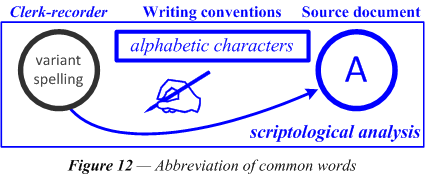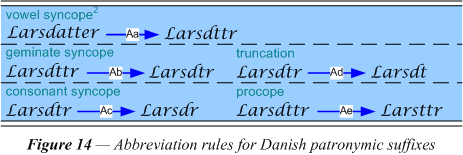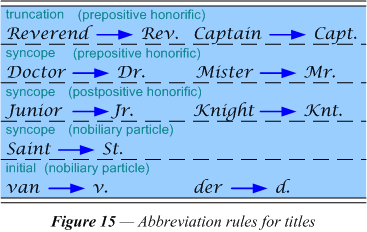
1.4 Abbreviation. The written system of a language and the habits of a clerk in executing it may make the representation of a name relatively tedious. For this reason clerks in the Middle Ages continually developed and used an abbreviation in place of the full or more official form of a name. Even after printing was established the short forms of the incunabula were carried forward into that medium. This custom became very attractive in times when writing materials were expensive and brevity paid dividends monetarily.

Abbreviation occurs when the clerk as the recorder of a document intentionally creates a variant spelling by systematically omitting certain characters. The clerk often marks the fact with a period, apostrophe, or by raising the last letter or letters. Although abbreviation generally involves the omission of characters, it sometimes may in addition alter those that survive the process. One common way is to omit final characters. This is called truncation, which means ‘cutting off the end.’ Formerly it was also quite common to omit middle characters, which is called syncope, meaning ‘cutting out the middle.’ To indicate syncope the last character was often written smaller and raised above the line of writing. (A third kind of cutting off is procope, rarely used in abbreviation.)

Sometimes names made of different morphemes will abbreviate by truncating the first one, in which case an appostrophe marks the position of the missing letters. For example, the surname “Pettypoole” is regularly abbreviated to “P’poole” and the erstwhile patronymic “ObBrian” has become “O’Brian.” As an abbreviation is a variant of a name, it has an internal association to the name piece representing its full spelling, which is in the same name group. Hence, we say that the name piece “Benj.” is an abbreviation for the name piece “Benjamin.” A formerly used abbreviation for the Latin “Joannes” was “Jno.,” one letter shorter than the English version “John,” which might also appear as an abbreviation for the Germanic version “Johann.” One elaborate method of abbreviation occurs with names formed from the name “Christ,” such as “Christian” and “Christopher.” A very common practice in former times in Europe was to use the Greek initial of this title in given names formed from it.
The above examples show a variety of ways that the recorder may use truncation or syncope to abbreviate various common and/or long given names. However, an abbreviation may be a shortened form of a name of almost any category. The examples in figure 14 illustrate abbreviations of the Scandinavian feminine patronymic suffix. With these methods the recorder omits the vowels of the longer names that need to be shortened to fit the limited space allowed.

A set of one or more initials is simply an abbreviation taken to the extreme. It may represent 1) a given name phrase, 2) a surname phrase, 3) especially any nobiliary, or even 4) a rank designation. It consists of the initial letters of each of the pieces only. Hence, there may be Sir B. M. v. d. Xoferbg., Knt as an extreme example for Sir Bartholmew Martin von dem Christoferburg, Knight.

One of the items in the above figure illustrates the abbreviation of a nobiliary particle, which in this case becomes part of a hagionym. Such names may refer to the saints themselves, or to families (family names and surnames) or to localities with saints as namesakes.
It does not make sense to include an initial in the LEXICON, though one entry for each letter is not costly. The form ought be recognized and hence put in the right category (abbreviation) by the parser, but a search strategy to take advantage of its name group membership as a possible variant of a given name or of a surname would probably not be efficient. The initial implies an association between every name piece entry and every other entry that starts with the same letter. The modern practice of abbreviating all names except the first and last has given rise to the so-called middle initials. This practice also suggests that the phenomenon is too common to justify the extreme strategy of searching all names that begin with the same initial. The nature of this kind of abbreviation would probably best be accounted for in the matching phase — the initial and any name beginning with it would be counted as a partial match.
Other forms of truncation and apocope could probably be carried in the LEXICON. The above mentioned instance of an honorific in the pre-positive phrase accounts for many abbreviations, e.g.., Mr., Ms., Dr. An instance of social rank is found in post-nomial initials. These appear in the postpositive title phrase. There are also regularly accepted abbreviations for the comparative adjectives, Jr., Sr, that appears in that phrase. The use of abbreviation to initials has also become a way of creating new names, so that this phenomenon is covered in another section, cf. §2.2. This also happens when the comparative adjective III (the ‘Junior’ of a Junior) becomes the nickname Trey, cf. §6.
Among locality designations we find a number of quite common abbreviations. Certain localiy types, such as Mt. for Mount and Ft. for Fort and Co. for County are very frequently abbreviated. In addition directions are almost always truncated to a letter for each compass point, so that we get NWT for Northwest Territories, etc.
